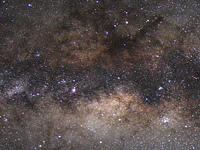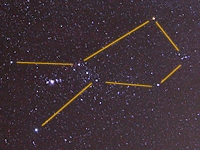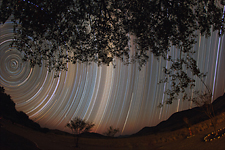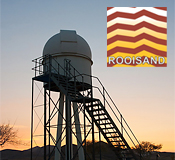 |
ROOISAND OBSERVATORY Widefield | SITEMAP HOME ROOISAND |
|
 |
|||
|
|
|||||||||||||||||
| Milky Way |
 |
Total lunar eclipse and Mars opposition on 27 July
2018 We, Franz Hofmann, Wolfgang Paech and Dirk Lucius were in Namibia for the total lunar eclipse on 27 July 2018. Beside the support of the lodge guests on Onjala and the inauguration of a planet path on the Rooisand Desert Ranch within the Voetstoots bicycle rally we could observe an impressive eclipse. In comparison to Germany, the eclipsed moon in Namibia was almost at its zenith. During totality it became so dark that the entire Milky Way was visible from horizon to horizon next to the red, full moon - a really fantastic sight. The entire duration of the eclipse could not be completely documented photographically by the astronomical assistance of the lodge guests. During totality, however, we were able to record some wide-angle impressions with a Fuji XM1 camera. Images of the total lunar eclipse, taken on Onjala, can be found on our chameleon page. Image data: 27.07.2018 — 3 x 20 Seconds, Fuji X-M1, 12mm/f:2.0 at ASA 1600 Location: Rooisand Observatory, Rooisand Desert Ranch, Namibia Image processing: Nebulosity, Photoshop CS5 High resolution 1800 x 1200 Pixel |
 |
Image data: 27.07.2018 — 4 x 20 Seconds, Fuji X-M1, 12mm/f:2.0 at ASA 1600 Location: Rooisand Observatory, Rooisand Desert Ranch, Namibia Image processing: Nebulosity, Photoshop CS5 High resolution 1800 x 1200 Pixel |
 |
The
Rooisand 3.2m dome under the Milky Way Image data: 08.08.2013 — 4 x 600 + 1 x 30 Seconds, Canon EOS 60 DA + Walimex 8mm at f/4 Location: Rooisand Observatory at Rooisand Desert Ranch, Namibia Image processing: Nebulosity, Registar, Photoshop CS5 High resolution 1800 x 1200 Pixel The widefield image shows the tower of the Rooisand observatory with the bright center of the Milky Way in zenith. In real life - with a clear sky this is a truly amazing view. |
 |
 |
 |
Milky
way and the Magellanic clouds at moonrise Location: Rooisand Observatory, Rooisand Desert Ranch, Namibia Click the thumbnails to see larger images. |
 |
The
rising Milky Way with Airglow Image data: 30.03.2014 — 6 x 15 Seconds, Canon EOS 6D + Tamron SP 24-70mm F/2.8 Di VC USD at 24 mm f/2.8 Location: Rooisand Observatory at Rooisand Desert Ranch, Namibia Image processing: Nebulosity, Photoshop CS5 Image 1024 Pixel High resolution 1800 x 1200 Over the mountains of Rooisand, the center of the Milky Way rises behind a green layer of Airglow. |
| Constellation |
 |
The
Big Dipper upon the nortern horizont Image data: 30.03.2014 — 6 x 15 Seconds, Canon EOS 6D + Tamron SP 24-70mm F/2.8 Di VC USD at 33 mm f/2.8 Location: Rooisand Observatory at Rooisand Desert Ranch, Namibia Image processing: Nebulosity, Photoshop CS5 Image 1024 Pixel High resolution 1800 x 1200 High resolution 3200 x 2000 |
 |
Rising of the Magellanic clouds Image data: 14.08.2013 — 40 x 30 Seconds, Canon EOS 60DA + Canon EF-S 17-55mm f/2.8 IS USM at 17mm f/2.8 Location: Rooisand Observatory at Rooisand Desert Ranch, Namibia Image processing: Startrails, Photoshop CS5 Image 1024 Pixel High resolution 1800 x 1200 Both Magellanic Clouds came up exactly in the middle between the high palm trees of the Roisaand Desert Ranch. |
 |
The
Magellanic Clouds in a widefield view Image data: 12.08.2013 — 24 x 420 Seconds, Canon EOS 60 DA + Canon EF28-135mm f/3.5-5.6 IS USM at 33 mm f/4.5 Location: Rooisand Observatory at Rooisand Desert Ranch, Namibia Image processing: Nebulosity, Photoshop CS5 Image 1024 Pixel High resolution 1800 x 1200 Pixel |
| Zodiacal Light and Star Trails |
 |
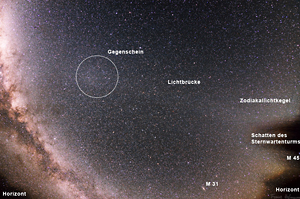 |
Zodiacal counterglow and zodiacal light Image data: 08.08.2013 — 12 x 600, Canon EOS 40 DA + Walimex 8 mm f/3.5 at f/4 Location: Rooisand Observatory at Rooisand Desert Ranch, Namibia Image processing: Registar, Photoshop CS5 High resolution 1400 x 1200 Pixel High resolution 1400 x 1200 Pixel with markings |
At first we was not really sure whether the oval spot was maybe an extension of the Milky Way, because the Gegenschein was still relatively close to the Milky Way at this time. But the location within the ecliptic was a strong indicator for it indeed to be the Gegenschein. Additionally a clearly visible zodiacal light (mainly caused by forward scattered sunlight) could be observed on the other side also indicating a very dark sky. The examination of the wide angle image nicely demonstrated that the zodiacal light was present along the entire ecliptic - starting from the light cone in direction of the sun (right side of image) via the very faint light bridge towards the Gegenschein, which fades over to the Milky Way on the left.
 |
Milky Way, the Magellanic clouds an Zodiac light at evening
twilight Bilddaten 2017 — Canon EOS 6 D Location: Rooisand Observatory, Rooisand Desert Ranch, Namibia Image processing: Nebulosity, Photoshop CS5 Medium resolution image with 1500 Pixel |
 |
Activity during mounting the new equipment in the Rooisand
dome Image data: 08.08.2013 — 598 x 25 Seconds, Canon EOS 400 D + Canon EF-S 17-55mm f/2.8 IS USM at 17 mm f/2.8 Location: Rooisand Observatory at Rooisand Desert Ranch, Namibia Image processing: Nebulosity, Photoshop CS5 Image 1024 Pixel Night time activities during setup of the new instruments at the Rooisand Observatory. Originally a video was planned, but the exposure were just too short to get a good result. That is why there is just the startrail. The both descending objects are the moon (at the very bottom) and the Venus above. |
 |
View to the southern pole Image data: 11.08.2013 — 32 x 600 Seconds, Canon EOS 400 D + Canon EF-S 17-55mm f/2.8 IS USM at17 mm f/2.8 Location: Rooisand Observatory at Rooisand Desert Ranch, Namibia Image processing: Nebulosity, Photoshop CS5 Image 1024 Pixel High resolution 1800 x 1200 Pixel |
 |
the
Rooisand dome in bright moonlight Image data: 13.08.2013 — 20 x 60 Seconds, Canon EOS 60 DA + EF-S 17-55mm f/2.8 IS USM at 21 mm f/3.5 Location: Rooisand Observatory at Rooisand Desert Ranch, Namibia Image processing: Nebulosity, Photoshop CS5 Image 1024 Pixel High resolution 1800 x 1200 Pixel laden |
 |
Setting of the Milky Way Image data: 14.08.2013 — 27 x 600 Seconds, Canon EOS 60 DA + EF-S 17-55mm f/2.8 IS USM at 21 mm f/3.5 Location: Rooisand Observatory at Rooisand Desert Ranch, Namibia Image processing: Nebulosity, Photoshop CS5 Image 1024 Pixel High resolution 1800 x 1200 Pixel |
 |
From the Southern Pole to the celestial
äquator Image data: 07.08.2013 — 39 x 600 Seconds, Canon EOS 60 DA + Walimex 8 mm f/3.5 at f/4 Location: Rooisand Observatory at Rooisand Desert Ranch, Namibia Image processing: Nebulosity, Photoshop CS5 Image 1024 Pixel High resolution 1800 x 1200 Pixel laden |
 |
The
Moon is setting at the Rooisand Desert Ranch Image data: 13.08.2013 — 205 x 60 Seconds, Canon EOS 400 D + Walimex 8 mm f/3.5 at f/4 Location: Rooisand Observatory at Rooisand Desert Ranch, Namibia Image processing: Nebulosity, Photoshop CS5 Image 1024 Pixel High resolution 1800 x 1200 Pixel The image was created at the last evening at Rooisand and shows the trail of the car going back to the farm while the camera was still taking pictures. |
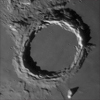 |
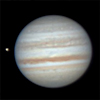 |
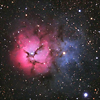 |
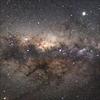 |
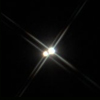 |
| Moon | Solar System | DeepSky | Widefield | Miscellaneous |
